Secure Z-MAC Protocol as a Proposed Solution for Improving Security in WSNs
Abstract
:1. Introduction
- (1)
- Increasing the security of WSNs implemented in various networks, such as the transportation network, smart city network, and complex communication networks;
- (2)
- Studies of future researchers when they are discussing implementing a new framework to increase security in WSNs and its applications;
- (3)
- Safe data transfer with the encryption of packets using the elliptic curve’s efficient and lightweight characteristics, which would led to attaining high throughput without compromising network security.
2. Literature Review
2.1. Types of Security Attacks in Networks
2.2. Significance of Security in Sensor Networks
2.3. Elliptic-Curve Encryption and the IHOP Mechanism for Key Generation
- A network’s nodes decide on an elliptic curve and a fixed curve point F, which are not a secret in the network;
- Node A selects a secret random integer Ak, which is a secret key, and a curve point AP = AkF is calculated, which is considered a public key;
- Node B also engages in a similar process as the one conducted by Node A;
- Node A randomly selects an integer Bk and it is considered a secret key that is not to be shared publicly. After that, it calculates the curve point BP = BkF as its public key;
- Once the secret key is generated, Node A wants to send a message to Node B;
- Node A can simply compute AkBP and use the final developed outcome as the secret key for encrypting a conventional symmetric block;
- After this step, Node B can further calculate a similar value by evaluating BkAP, because
- The initial stage is installation and the setting-up stage for nodes. In this stage, the main server provides each node with a distinctive and different identification code, and provides them with the keying resources needed to establish paired keys with some other nodes. After setup, a node generates a one-hop paired key with each of its neighbors.
- The second stage is the association discovery stage, which has two further stages known as the base-station hello stage and the cluster acknowledgment stage. In the base-station hello stage, the base station sends a HELLO message to all the nodes; this allows them to store the identification codes of the nearby t + 1 nodes, which are on the path towards the base station. In the cluster acknowledgment stage, the cluster head of the network sends an acknowledgment to the base station.
- The third step is the report endorsement phase, in which t + 1 nodes cooperate to generate a report when they detect the existence of an event occurrence. To be more specific, each participating node computes two MACs over the event—one by the key supplied by the base station and the other employing the bilateral key shared with the nodes above. The MAC addresses are then sent to the cluster head. The cluster head collects MAC addresses from all the nodes in the network, combines them into a transmission message, and transmits it to the base station.
- The fourth stage, en-route filtering, involves each sending node validating the message authentication code (MAC) produced by its subordinate associated and connected nodes, before excluding it from the receiving report. Following successful verification, the node creates and deploys a new MAC, with the bilateral key exchanged with the upper connected node. Lastly, it sends the information to its next node throughout the route of the base station.
- Following the receipt of the message, the base station validates it in the last stage, known as the base-station verification stage. If the base station determines that the communication was properly authorized by the t + 1 nodes, it acknowledges the message; otherwise, it dismisses it.
2.4. Z-MAC Protocol
3. Proposed Solution—Secure Z-MAC
3.1. Secure Z-MAC Protocol
- The step of neighbor discovery starts with the use of a neighborhood detection algorithm. The present method monitors at 30 s at irregular intervals. The network nodes that store data about one-hop neighbors, acquired through ping requests and messages, verify nodes within two hops. The energy used by DRAND is proportionate to the time when the transmission schedule is given. An attacker may impersonate a genuine node by using node replication. A new intruder, for example, might connect to the network as a neighbor and transmit incorrect data. Therefore, hierarchical keys are created by distributing the primary key and shared keys among n + 1 nodes.
- In the local framing stage, each node can retain a local time allotment that is proportional to the extent of its neighborhood, while remaining strategically far from any dispute with competing neighbors. If node A is in a two-hop neighborhood but uses a time slot granted by node B for whatever reason, the effect will last until the nth slot. The transmission rule enables DRAND to assign nodes to the nth time frame within the anticipated time range. Once a node achieves this level, it is only allowed to utilize its very own slots once every six seconds under any circumstance. In the Z-MAC protocol, CSMA is permitted to access empty slots to guarantee that they are completely used. The process of local framing is presented in the Figure 5.
- In the transmission control stage, during the startup, the Z-MAC algorithm has a fixed slot allocation. A node is considered to exist in High Contention Level (HCL) mode when it obtains an explicit contention notice (ECN) in the nth time frame. When sending in Low Contention Level (LCL) mode, each node may select any time frame to send the packet; however, only the node’s one-hop neighbor and owner are permitted to send. This will help to build trust among nodes, and also generate safe, secure, and encrypted private keys. When a node is prepared to send data in the nth slot, it is verified to check whether it holds the slot. If this is not the case, the data are transmitted when the slot is operational. If the connection is free, the node takes the slot; otherwise, it waits until the channels are available. Even though a node has additional time, an interchange will be rejected if the broadcast does not finish within the timespan of the availability.
- In the ECN stage, the ECN is sent to the nodes about the LCL or HCL condition for slot assignment. After each schedule, the node sends the ECN notifications to check whether any other nodes are competing for a similar data transmission slot. When node-to-node contention in slots rises, the channel’s size generally expands as well. MICA2 was used to examine interactions between the transmitters and the two-hop neighbor of the sender.
- The fifth stage is receiving the schedule of Z-MAC. Although the Z-MAC and B-MAC protocols approach energy consumption differently, both are identified as idle monitoring devices during periods of low movement. Because a node in the HCL communicates exclusively between two specified areas, a high slot size may lead to considerable latency. When there is minimal contention, storage has little impact on transmission delay, since nodes are constantly preparing to transmit data. There is a strong connection between system latency and slot size. As a result, a big slot size may result in an inordinate amount of delay.
- In the local time synchronization stage, periodic synchronization is required for the Z-MAC protocol to run the HCL in the case of several collisions. This method allows passive receivers to sync their clocks with the data sent by the transmitter without requiring any synced communication. This Z-MAC method would be employed to synchronize the clock timings of every node and calculate a weighted moving average among them, allowing for the preservation of a trust factor. As a result, the receiving nodes will know which one to trust, as a new node will be unaware of the time gap between the nodes. Due to the extra packets sent and received by the node that exchanges synchronization signals in this network, the node that sends and accepts synchronized signals often has a higher trust element than the other nodes.
3.2. Secure Z-MAC Algorithm
| Algorithm 1 Secure Z-MAC Algorithm |
|
4. Research Methodology and Security Analysis of the Developed Protocol
5. Results
5.1. Experimental Setup
5.2. Experimental Results
5.2.1. First Simulation
5.2.2. Second Simulation
5.2.3. Third Simulation
5.2.4. Flooding Attack
5.2.5. Blackhole Attack
5.2.6. DDOS Attack
5.3. Z-MAC and the Secure Z-MAC Protocol
6. Discussion
- (1)
- It conducted a security analysis of the secure Z-MAC protocol using code analysis and statistical analysis to ensure that the protocol is valid and secure.
- (2)
- It allowed improvement of the simulations, which helped in making sure that the WSN is secure from the malicious attacks such as flooding attacks, blackhole attack, and DDOS attack.
7. Conclusions
Author Contributions
Funding
Institutional Review Board Statement
Informed Consent Statement
Data Availability Statement
Conflicts of Interest
References
- Stankovic, J.A. Wireless sensor networks. Computer 2008, 41, 92–95. [Google Scholar] [CrossRef] [Green Version]
- Severino, R.; Batsa, M.; Alves, M.; Koubaa, A. A Traffic Differentiation Add-On to the IEEE 802.15. 4 Protocol: Implementation and experimental validation over a real-time operating system. In Proceedings of the 2010 13th Euromicro Conference on Digital System Design: Architectures, Methods and Tools, Lile, France, 1–3 September 2010; IEEE: Piscataway, NJ, USA, 2010; pp. 501–508. [Google Scholar] [CrossRef] [Green Version]
- Warrier, A.; Aia, M.; Sichitiu, M. Z-MAC: A hybrid MAC for wireless sensor networks. IEEE/ACM Trans. Netw. 2010, 16, 511–524. [Google Scholar] [CrossRef]
- Landwehr, C.E.; Goldschlag, D.M. Security issues in networks with Internet access. Proc. IEEE 1997, 85, 2034–2051. [Google Scholar] [CrossRef]
- Kosachenko, T.; Dudkin, D.; Konev, A.; Sharamok, A. Threat Model for Trusted Sensory Information Collection and Processing Platform. In International Conference on Futuristic Trends in Networks and Computing Technologies; Springer: Singapore, 2020; pp. 296–304. [Google Scholar] [CrossRef]
- Alghamdi, T.A. Convolutional technique for enhancing security in wireless sensor networks against malicious nodes. Hum.-Cent. Comput. Inf. Sci. 2019, 9, 38. [Google Scholar] [CrossRef]
- Rai, A.K.; Tewari, R.R.; Upadhyay, S.K. Different types of attacks on integrated manet-internet communication. Int. J. Comput. Sci. Secur. 2010, 4, 265–274. [Google Scholar]
- Chakravarty, S.; Portokalidis, G.; Polychronakis, M.; Keromytis, A.D. Detection and analysis of eavesdropping in anonymous communication networks. Int. J. Inf. Secur. 2019, 14, 205–220. [Google Scholar] [CrossRef]
- Bello, A.D.; Lamba, O.S. How to Detect and Mitigate Sinkhole Attack in Wireless Sensor Network (WSN). Int. J. Eng. Res. Technol. 2020, 9. [Google Scholar]
- Hasbullah, H.; Soomro, I.A. Denial of service (DOS) attack and its possible solutions in VANET. Int. J. Electr. Comupt. Eng. 2010, 4, 813–817. [Google Scholar]
- Matin, M.A.; Islam, M.M. Overview of wireless sensor network. In Wireless Sensor Networks-Technology and Protocols; Intech Open: London, UK, 2012; pp. 1–3. [Google Scholar]
- Wazid, M.; Katal, A.; Sachan, R.S.; Goudar, R.H.; Singh, D.P. Detection and prevention mechanism for blackhole attack in wireless sensor network. In Proceedings of the 2013 International Conference on Communication and Signal Processing, Melmaruvathur, India, 3–5 April 2013; IEEE: Piscataway, NJ, USA, 2013; pp. 576–581. [Google Scholar] [CrossRef]
- Wang, S.Y.; Hsu, Y.J.; Hsiao, S.J. Integrating blockchain technology for data collection and analysis in wireless sensor networks with an innovative implementation. In Proceedings of the 2018 International Symposium on Computer, Consumer and Control (IS3C), Taichung, Taiwan, 6–8 December 2018; IEEE: Piscataway, NJ, USA, 2018; pp. 149–152. [Google Scholar]
- Hsiao, S.J.; Sung, W.T. Employing Blockchain Technology to Strengthen Security of Wireless Sensor Networks. IEEE Access 2021, 9, 72326–72341. [Google Scholar] [CrossRef]
- Louw, J.; Niezen, G.; Ramotsoela, T.D.; Abu-Mahfouz, A.M. A key distribution scheme using elliptic curve cryptography in wireless sensor networks. In Proceedings of the 2016 IEEE 14th International Conference on Industrial Informatics (INDIN), Poitiers, France, 19–21 July 2016; IEEE: Piscataway, NJ, USA, 2016; pp. 1166–1170. [Google Scholar]
- Pritchard, S.W.; Hancke, G.P.; Abu-Mahfouz, A.M. Cryptography methods for software-defined wireless sensor networks. In Proceedings of the 2018 IEEE 27th International Symposium on Industrial Electronics (ISIE), Cairns, Australia, 13–15 June 2018; IEEE: Piscataway, NJ, USA, 2018; pp. 1257–1262. [Google Scholar]
- Cheng, X.; Luo, Y.; Gui, Q. Research on trust management model of wireless sensor networks. In Proceedings of the 2018 IEEE 3rd Advanced Information Technology, Electronic and Automation Control Conference (IAEAC), Chongqing, China, 12–14 October 2018; IEEE: Piscataway, NJ, USA, 2018; pp. 1397–1400. [Google Scholar]
- Sagar, S.; Mahmood, A.; Sheng, Q.Z.; Zhang, W.E. Trust computational heuristic for social Internet of Things: A machine learning-based approach. In Proceedings of the ICC 2020–2020 IEEE International Conference on Communications (ICC), Online, 7–11 June 2020; IEEE: Piscataway, NJ, USA, 2020; pp. 1–6. [Google Scholar]
- Du, X.; Chen, H.H. Security in wireless sensor networks. IEEE Wirel. Commun. 2008, 15, 60–66. [Google Scholar] [CrossRef]
- Teymourzadeh, M.; Vahed, R.; Alibeygi, S.; Dastanpour, N. Security in wireless sensor networks: Issues and challenges. arXiv 2020, arXiv:2007.05111. [Google Scholar]
- Mittal, H. A survey: Attacks on wireless networks. J. Netw. Commun. Emerg. Technol. 2016, 3–7. [Google Scholar]
- Al-Janabi, S.; Al-Shourbaji, I.; Shojafar, M.; Shamshirband, S. Survey of main challenges (security and privacy) in wireless body area networks for healthcare applications. Egypt. Inform. J. 2017, 18, 113–122. [Google Scholar] [CrossRef] [Green Version]
- Garcia-Font, V.; Garrigues, C.; Rifà-Pous, H. Attack classification schema for smart city WSNs. Sensors 2017, 17, 771. [Google Scholar] [CrossRef] [PubMed] [Green Version]
- Ahmad, I.; Shah, K.; Ullah, S. Military applications using wireless sensor networks: A survey. Int. J. Eng. Sci. 2016, 6, 7039. [Google Scholar]
- Kang, B.; Shao, D.; Wang, J. A fair electronic payment system for digital content using elliptic curve cryptography. J. Algorithm. Comput. Technol. 2018, 12, 13–19. [Google Scholar] [CrossRef] [Green Version]
- Hankerson, D.; Menezes, A.J.; Vanstone, S. Guide to Elliptic Curve Cryptography; Springer Science & Business Media: Berlin/Heidelberg, Germany, 2006. [Google Scholar]
- Batina, L.; Mentens, N.; Sakiyama, K.; Preneel, B.; Verbauwhede, I. Low-cost elliptic curve cryptography for wireless sensor networks. In European Workshop on Security in Ad-hoc and Sensor Networks; Springer: Berlin/Heidelberg, Germany, 2006; pp. 6–17. [Google Scholar] [CrossRef] [Green Version]
- Zhu, S.; Setia, S.; Jajodia, S.; Ning, P. Interleaved hop-by-hop authentication against false data injection attacks in sensor networks. ACM Trans. Sens. Netw. 2007, 3, 14-es. [Google Scholar] [CrossRef]
- Rhee, I.; Warrier, A.; Min, J.; Xu, L. DRAND: Distributed randomised TDMA scheduling for wireless ad hoc networks. IEEE Trans. Mob. Comput. 2009, 8, 1384–1396. [Google Scholar] [CrossRef]
- Arshad, S.; Al-Sadi, A.; Barnawi, A. Z-MAC: Performance evaluation and enhancements. Procedia Comput. Sci. 2013, 21, 485–490. [Google Scholar] [CrossRef] [Green Version]
- Lu, J.; Yao, L.; He, X.; Huang, C.; Wang, D.; Meng, B. A security analysis method for security protocol implementations based on message construction. Appl. Sci. 2018, 8, 2543. [Google Scholar] [CrossRef] [Green Version]
- Alotaibi, M. Security to wireless sensor networks against malicious attacks using Hamming residue method. J. Wirel. Commun. Netw 2019, 2019, 8. [Google Scholar] [CrossRef] [Green Version]
- Porambage, P.; Schmitt, C.; Kumar, P.; Gurtov, A.; Ylianttila, M. PAuthKey: A Pervasive Authentication Protocol and Key Establishment Scheme for Wireless Sensor Networks in Distributed IoT Applications. Int. J. Distrib. Sens. Netw. 2014, 10. [Google Scholar] [CrossRef]
- Kim, J.; Moon, J.; Jung, J.; Won, D. Security Analysis and Improvements of Session Key Establishment for Clustered Sensor Networks. J. Sens. 2016, 2016, 4393721. [Google Scholar]
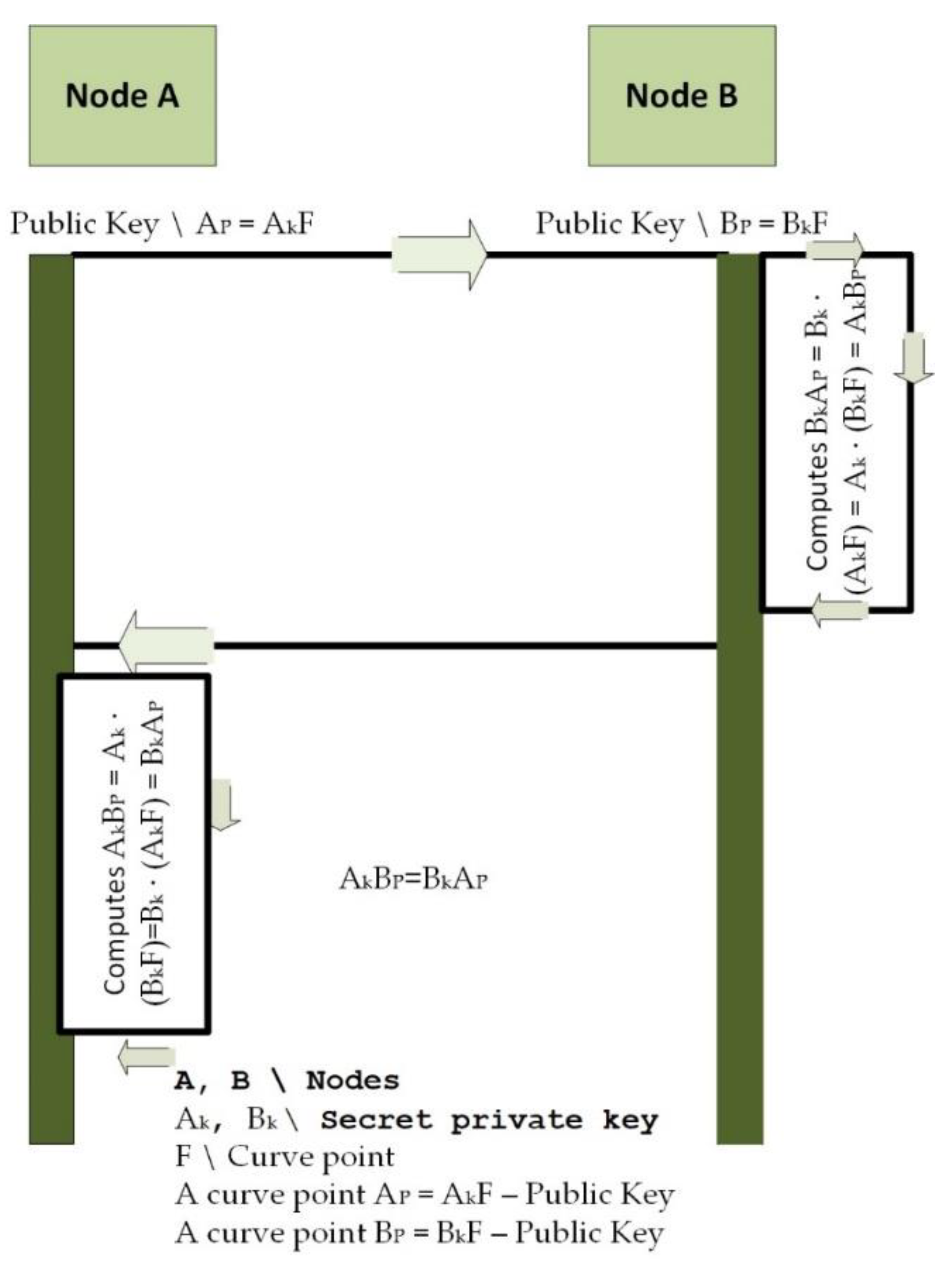
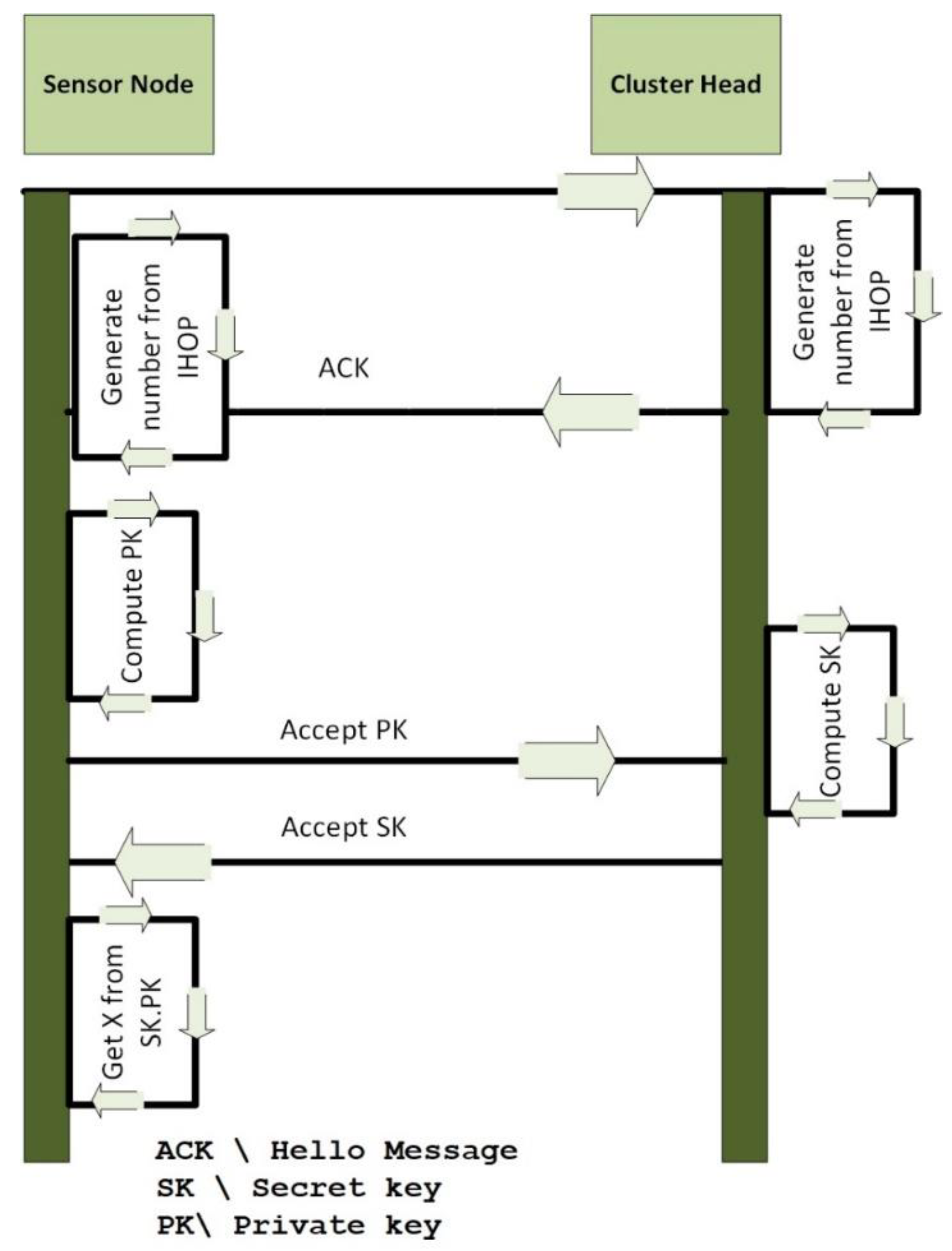
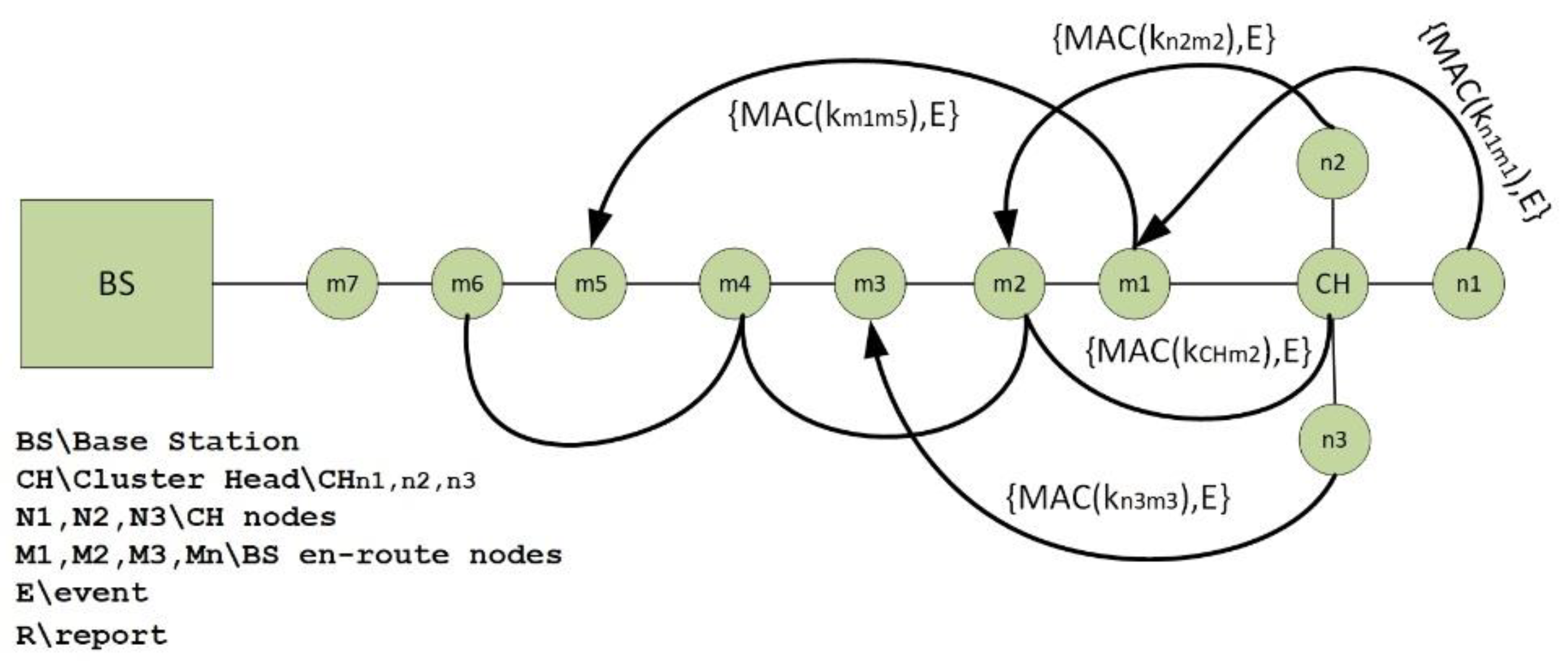


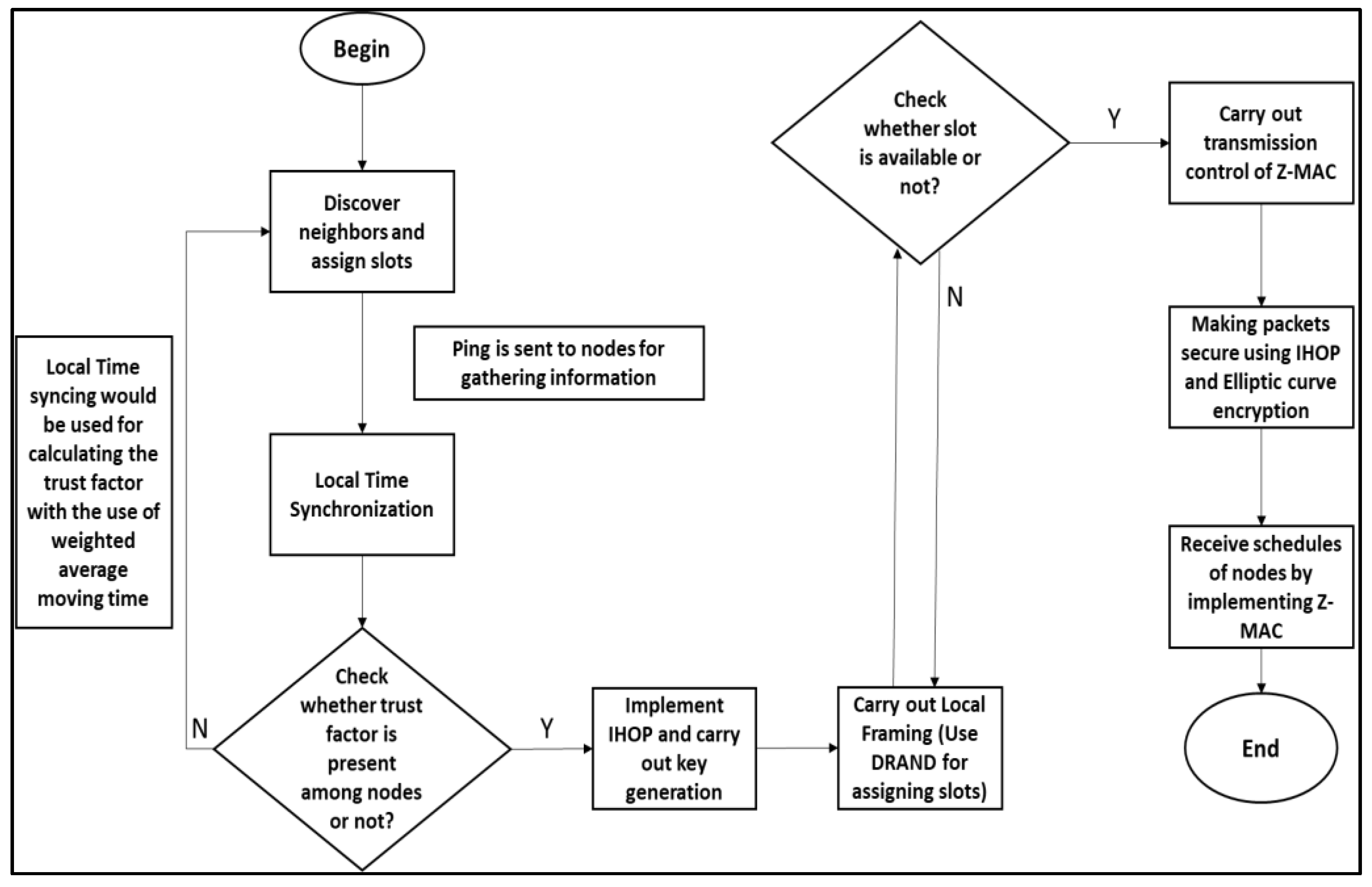

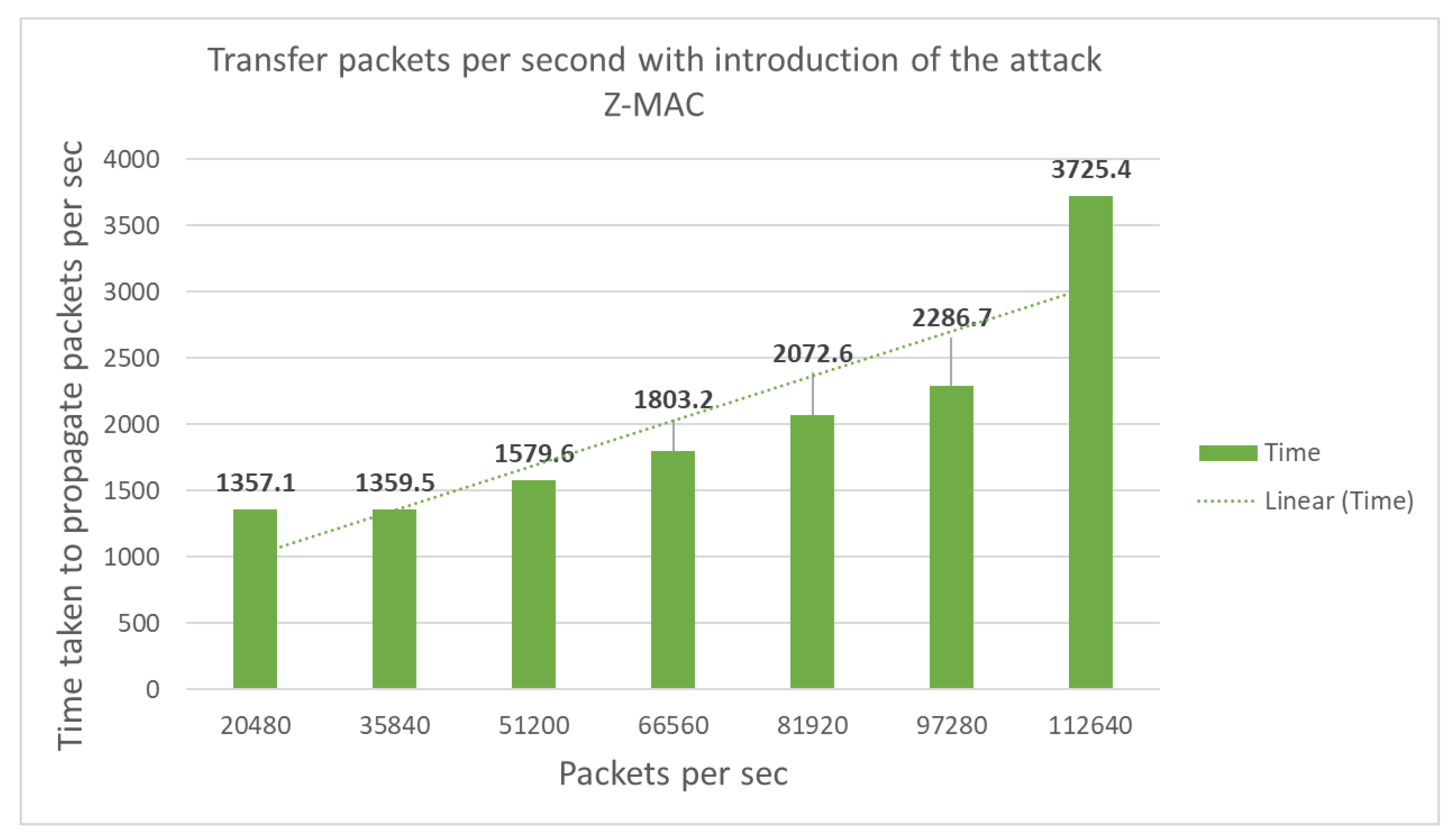


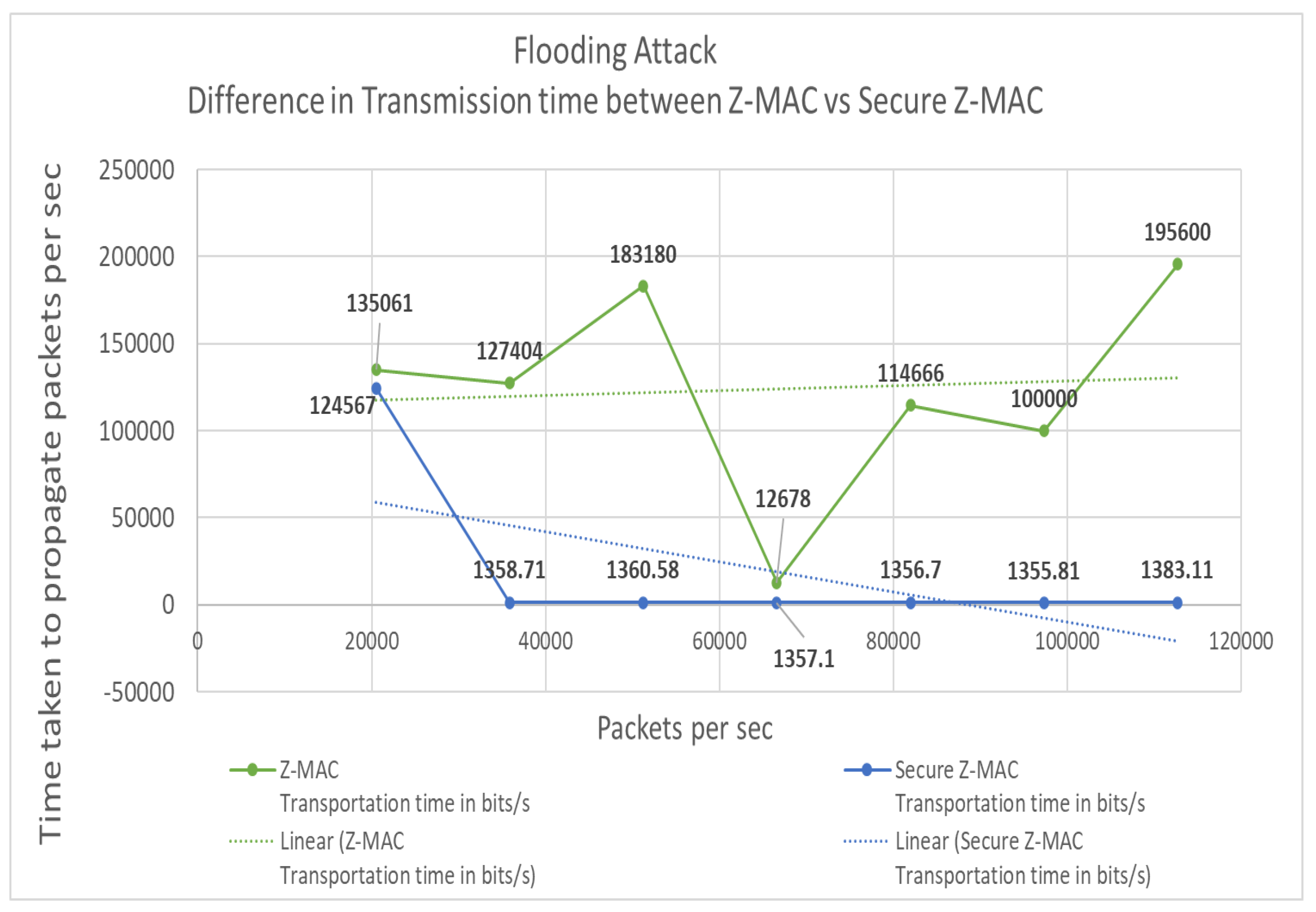
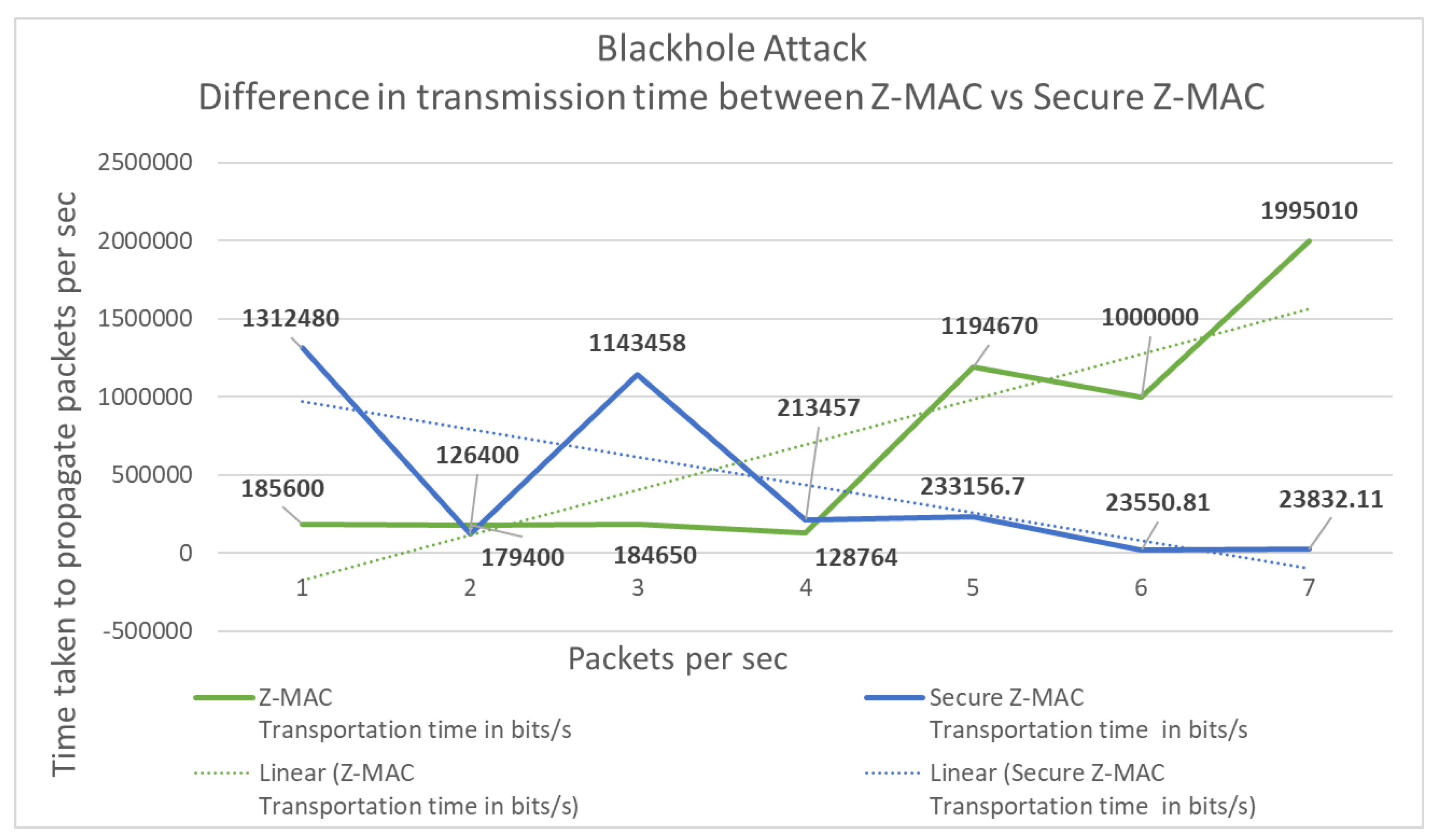

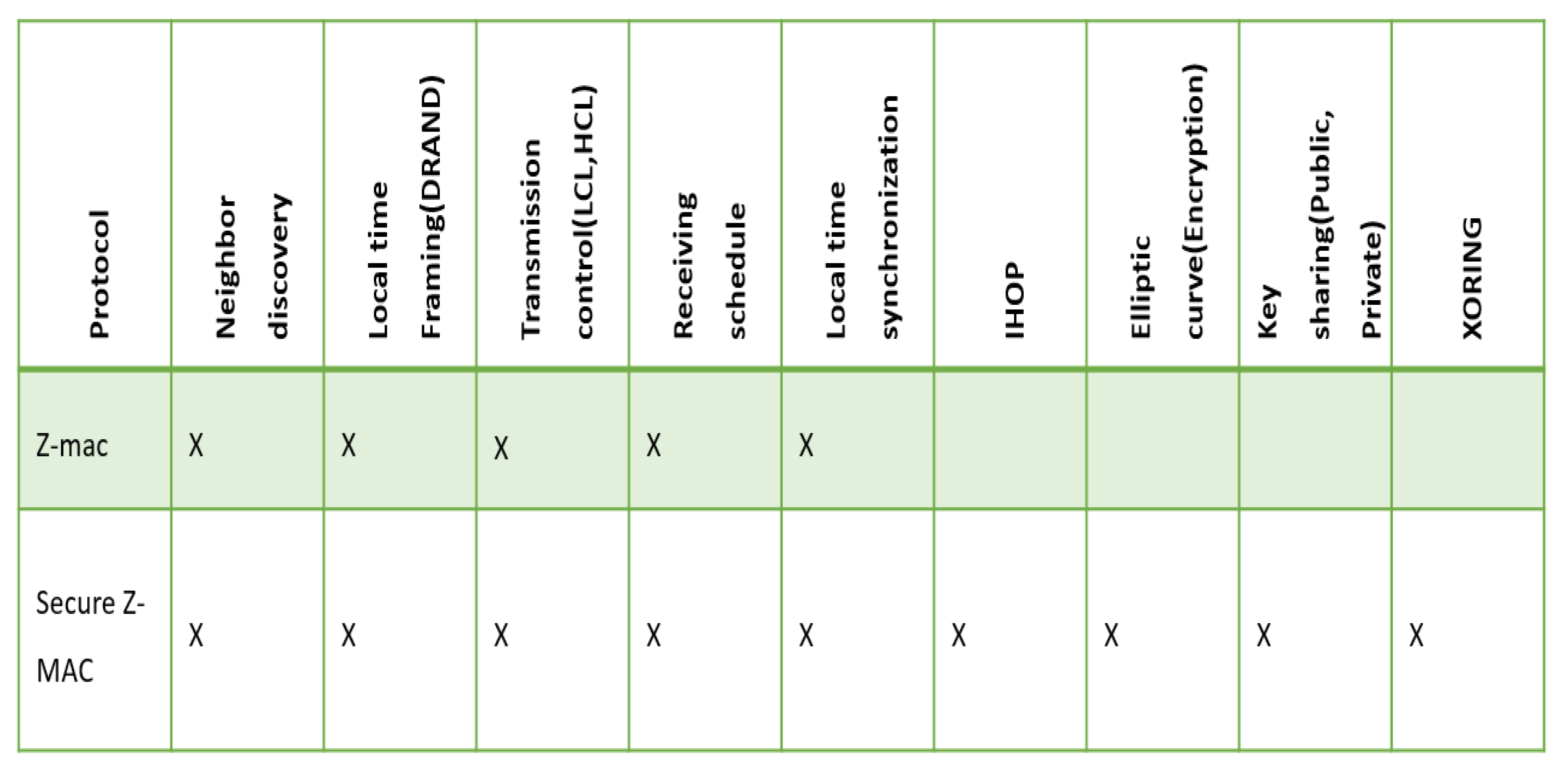
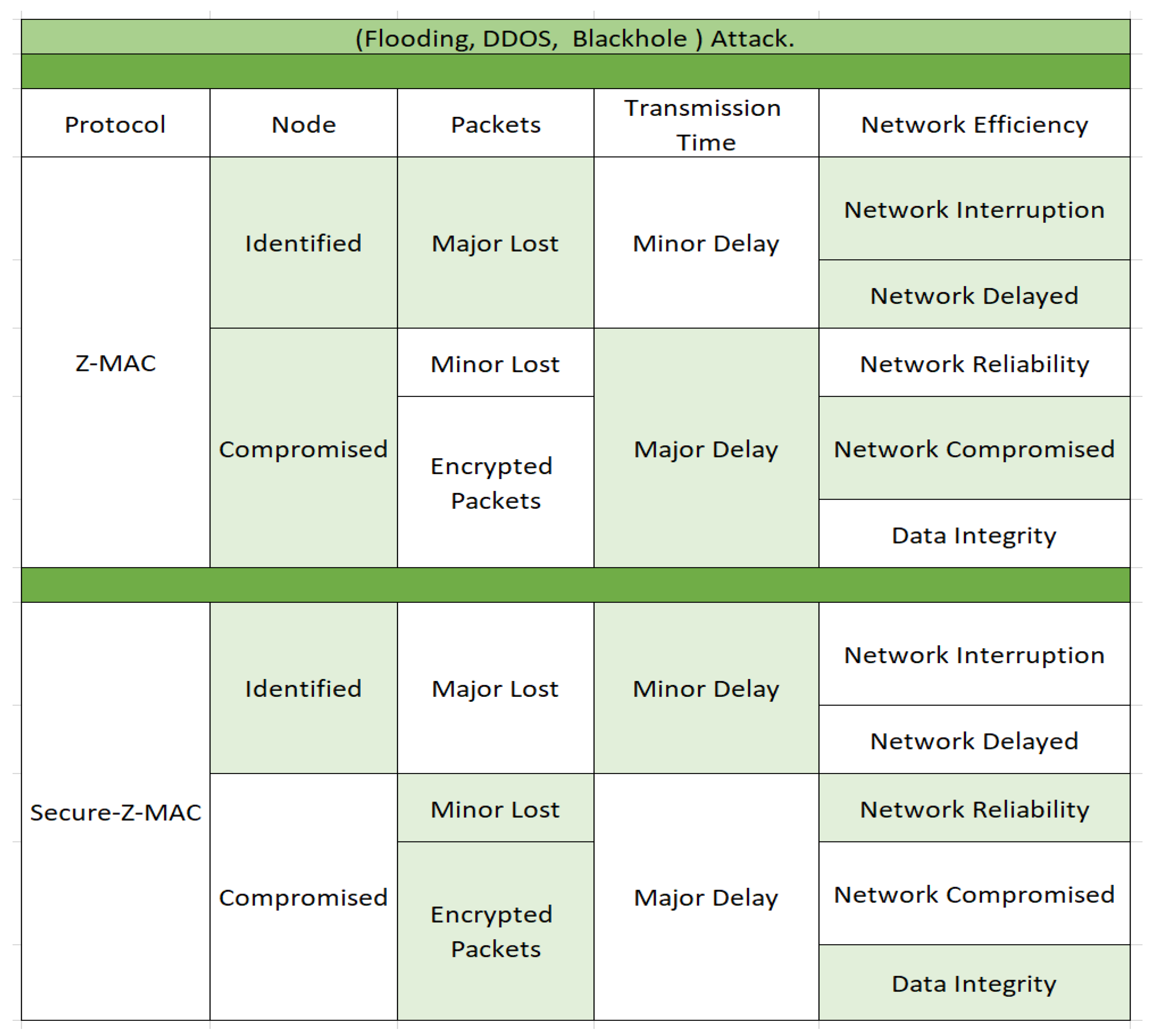
| Attack | Type of Attack | Description |
|---|---|---|
| Eavesdropping attack | External and internal | The action of an illegal party intercepting information and data is known as eavesdropping. Because of the dispersed nature of the broadcast channel, any attacker may capture messages at a selected frequency and obtain confidential data about a system’s operational processes, as well as see physical characteristics by employing a sensor node [8]. |
| Sinkhole attack | External and internal | A sinkhole attack occurs when an attacker or hostile sensor node disguises itself as a sinkhole in such a way as to entice and collect all traffic in a sensor network. An attacker listens in on-demand patterns, then presents these to the targeted system as having the best efficiency or being the quickest path to the base station. By placing itself between cooperative nodes, the intruder is likely to modify the data passing between them and launch an attack, rendering the WSN very susceptible [9]. |
| DoS attack | External and internal | By partially or fully stopping the activities of a server connected to the Internet, an attacker tries to make a computer, networking device, or program unavailable to its intended clients. A DoS attack is often carried out by bombarding the targeted computer or services with numerous queries in an attempt to overload networks and prevent some or all legitimate requests from being fulfilled [10]. |
| Flooding attack | External and internal | The flooding attack allows intruders to possibly send a huge amount of traffic to particular servers or applications to deplete all of their resources responding to false traffic, leaving them unable to fulfill legitimate service requests [11]. |
| Blackhole attack | External and internal | An unauthenticated node that is likewise an eavesdropper serves as a blackhole, monitoring for request packet communications from its neighbors and responding with incorrect and misleading information about the shortest route to the sink node [12]. |
| Parameters | Values |
|---|---|
| Number of nodes | 5, 10, 15, 20, 25, 30, and 35 |
| Area size | 25 × 25 |
| Wireless bandwidth (In Mbps) | 2 |
| Simulation duration (bit/sec) | 1000–3000 |
| Packet size | 20,000–120,000 |
| Number of CH | 1 |
| Types of attacks discussed | 3 |
| Number of attack nodes | 1,2,3, …, n + 1 |
| Nodes | Packets/sec in Bytes | Time in bits/s |
|---|---|---|
| 5 | 20480 | 1361.78478 |
| 10 | 35840 | 1367.985821 |
| 15 | 51200 | 1379.645156 |
| 20 | 66560 | 1403.241674 |
| 25 | 81920 | 1443.686908 |
| 30 | 97280 | 1489.758152 |
| 35 | 112640 | 1576.497647 |
| Nodes | Packets/sec in Bytes | Time in bits/s |
|---|---|---|
| 5 | 20480 | 1357.1 |
| 10 | 35840 | 1359.5 |
| 15 | 51200 | 1579.645156 |
| 20 | 66560 | 1803.241674 |
| 25 | 81920 | 2072.686908 |
| 30 | 97280 | 2286.758152 |
| 35 | 112640 | 3725.497647 |
| Nodes | Packets/sec in Bytes | Time in bits/s |
|---|---|---|
| 5 | 20480 | 1358.598129 |
| 10 | 35840 | 1361.77138 |
| 15 | 51200 | 1366.963776 |
| 20 | 66560 | 1371.648392 |
| 25 | 81920 | 1375.062767 |
| 30 | 97280 | 1389.011017 |
| 35 | 112640 | 1409.034265 |
| Nodes | Packets/sec in Bytes | Time in bits/s |
|---|---|---|
| 5 | 20480 | 1418.014112 |
| 10 | 35840 | 1464.402046 |
| 15 | 51200 | 1536.198699 |
| 20 | 66560 | 1645.619443 |
| 25 | 81920 | 1738.530628 |
| 30 | 97280 | 1833.294729 |
| 35 | 112640 | 1905.975264 |
| Nodes | Packets/sec in Bytes | Z-MAC Transmission Time in bits/s | Secure Z-MAC Transmission Time in bits/s |
|---|---|---|---|
| 5 | 20480 | 135061 | 124567 |
| 10 | 35840 | 127404 | 1358.71 |
| 15 | 51200 | 183180 | 1360.58 |
| 20 | 66560 | 12678 | 1357.1 |
| 25 | 81920 | 114666 | 1356.7 |
| 30 | 97280 | 100000 | 1355.81 |
| 35 | 112640 | 195600 | 1383.11 |
| Nodes | Packets/sec in Bytes | Z-MAC Transmission Time in bits/s | Secure Z-MAC Transmission Time in bits/s |
|---|---|---|---|
| 5 | 50480 | 185600 | 1312480 |
| 10 | 65840 | 179400 | 126400 |
| 15 | 81200 | 184650 | 1143458 |
| 20 | 560566 | 128764 | 213457 |
| 25 | 781920 | 1194670 | 233156.7 |
| 30 | 9007280 | 1000000 | 23550.81 |
| 35 | 10012640 | 1995010 | 23832.11 |
| Nodes | Packets/sec in Bytes | Z-MAC Transmission Time in bits/s | Secure Z-MAC Transmission Time in bits/s |
|---|---|---|---|
| 5 | 50480 | 115509 | 152461 |
| 10 | 65840 | 139450 | 124000 |
| 15 | 81200 | 144295 | 133690 |
| 20 | 560566 | 161930 | 140442 |
| 25 | 781920 | 194636 | 158101 |
| 30 | 9007280 | 211430 | 153561 |
| 35 | 1001264 | 241873 | 159023 |
Publisher’s Note: MDPI stays neutral with regard to jurisdictional claims in published maps and institutional affiliations. |
© 2022 by the authors. Licensee MDPI, Basel, Switzerland. This article is an open access article distributed under the terms and conditions of the Creative Commons Attribution (CC BY) license (https://creativecommons.org/licenses/by/4.0/).
Share and Cite
Almansoori, M.N.; Elshamy, A.A.; Mustafa, A.A.M. Secure Z-MAC Protocol as a Proposed Solution for Improving Security in WSNs. Information 2022, 13, 105. https://doi.org/10.3390/info13030105
Almansoori MN, Elshamy AA, Mustafa AAM. Secure Z-MAC Protocol as a Proposed Solution for Improving Security in WSNs. Information. 2022; 13(3):105. https://doi.org/10.3390/info13030105
Chicago/Turabian StyleAlmansoori, Mona Nasser, Ahmad Ahmad Elshamy, and Ahmad Abdel Muttalib Mustafa. 2022. "Secure Z-MAC Protocol as a Proposed Solution for Improving Security in WSNs" Information 13, no. 3: 105. https://doi.org/10.3390/info13030105
APA StyleAlmansoori, M. N., Elshamy, A. A., & Mustafa, A. A. M. (2022). Secure Z-MAC Protocol as a Proposed Solution for Improving Security in WSNs. Information, 13(3), 105. https://doi.org/10.3390/info13030105






